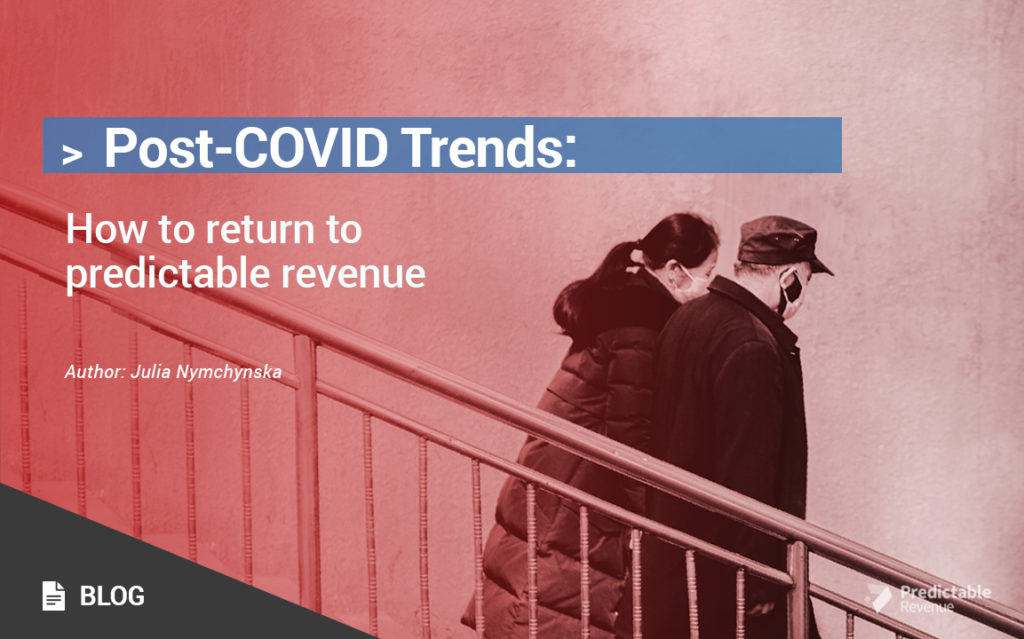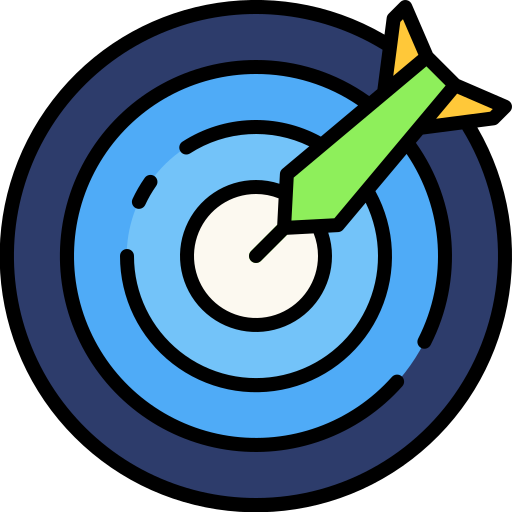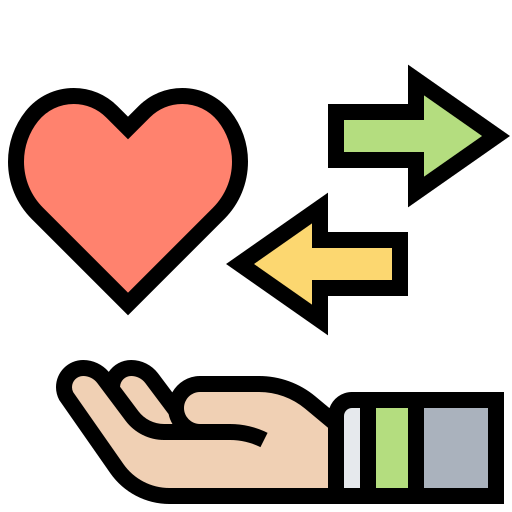Post-COVID Trends: How to Return to Predictable Revenue

Author: Julia Nymchynska
COVID-19 changed the world like nothing else in our history.
Almost overnight, the sales landscape shifted. Offline demonstrations and presentations became webinars, and video meetings. Events and expos transformed into online experiences.
Yet, despite the incredible disruption that the pandemic caused, companies have managed to survive. Sales organizations adapted impressively to the new reality imposed by COVID-19. Though some organizations felt the impact worse than others, many teams leapt quickly into the new landscape.
According to studies from B2B social channel, LinkedIn, salespeople are thriving in the new remote and virtual environment. 77% said that they were already hosting more video meetings, and 51% began sending more emails.
Although companies are beginning to slowly make their way back into the office, events and in-person experiences are still on-hold. Many experts believe that we’re not going to make our way back into the event space until at least 2021.
The good news? Your sales strategy doesn’t need to be on-hold.
LinkedIn research, and our own extensive report on the impact of COVID-19 on the sales pipeline, demonstrates some of the ways that companies can evolve.
The Trends Changing the Sales Landscape
Research into the world before and after COVID demonstrates that some trends previously considered “temporary” are now becoming more permanent. Things like remote working and digital selling aren’t just going to be features of the pandemic lockdown.
Today’s sales team leaders will need to know how to differentiate the new and long-lasting opportunities in the landscape, from the strategies that they can leave behind with the quarantine.
Here are just some of the biggest trends and challenges that teams need to consider going forward.
1. The focus will remain on the customer
Understanding the customer journey through extensive data and analytics has always been critical to business survival. Sales organizations learned during COVID-19 that customer satisfaction and loyalty is the key to staying ahead of the curve.
LinkedIn’s State of Sales report found that the top metric for measuring sales performance is “satisfaction” and “customer retention” (43% and 40%). In our own research, we also saw an increasing demand for stronger customer relationships.
Customers renewing their accounts with companies took up 78% of the opportunities for modern sales teams. Our research therefore demonstrates that companies will need to dedicate more of their time and attention to keeping existing customers happy.
While it’s always important to attract new customers to your sales pipeline, it’s also crucial to ensure that you’re not leaving your existing customers behind. Think about how you can adapt your services and solutions to suit the needs of your changing audience. It may be necessary to talk to your customers and access some new information here.

2. Data will drive future decisions
Data-driven decision making has played a valuable part in the sales landscape for several years now. The rise of embedded analytics tools, customer relationship management services, and engagement services has made unlocking information easier than ever.
Although many companies have already discovered the value that data analytics can bring to their organization, the COVID-19 landscape means that more companies will need to step into the data space and uncover deeper insights going forward. Adjusting to life and sales after COVID will mean reassessing your pipeline and learning what has changed.
Use your sales engagement tools to connect different components of your customer journey and get more information on your clients. According to LinkedIn, around 56% of salespeople are using data to prospect for their leads. Data is increasingly becoming an essential component of every part of the sales strategy.
That takes us onto the next trend that companies need to consider as they move into their life after COVID-19.
3. The Demand for Sales Technology is Increasing
A digital revolution is happening in every industry. Now that millennials are set to make up around 45% of the global workforce by 2025, they’re bringing more technology into the workplace. That’s great news for a world where face-to-face meetings might not be possible all the time.
As lockdowns and quarantines reduced the possibility for face-to-face interactions, companies discovered that sales technology is the perfect route forward for the sales organization. LinkedIn found tat around 74% of salespeople using sales intelligence tools think they’re essential to closing sales.
Other studies into the evolution of sales technology are driving new results too. For instance, Aragon believes that the sales enablement environment will reach a value of $5 billion by next year. As the number of tools that today’s companies rely on continues to grow and evolve, we’ll see an ever-increasing demand for more technology to help with the customer journey.
Going forward, sales leaders will need to continue to focus on building their digital presence and using technology wherever possible. This could mean investing in tools for webinars and online demonstrations or tracking conversations with clients to see what new technology is necessary.
Sales enablement tools and customer revenue optimization software can offer new insights for team members, and guide business leaders into making the right decisions.
4. Trust and Empathy are Essential
Above, we mentioned that the customer will be the main focus point of countless businesses in the current sales environment. For organizations to thrive in this landscape, they’ll need to create an identity that their clients can trust.
In the last few months, we’ve seen countless companies striving to show their customers how much they understand them and empathize with their situation. For instance, Deliveroo launched the first contact-free delivery service in the UK to ensure that customers didn’t have to interact with drivers during lockdown.
Companies like Starbucks started to give free drinks to essential and key workers. Sales and discounts emerged from every industry, demonstrating the opportunities that companies had to help their clients thrive in a challenging environment.
Work like this not only improves the reputation of leading brands. The more you show your customers that you care about them, the more they’ll trust that you have their best interests at heart. Unfortunately, according to LinkedIn, only around 40% of people say that the sales profession is trustworthy. However, 88% of customers say that they always buy from “trustworthy advisors.”
It’s time to think more carefully about how you can show your customers that they can trust you. Would it be possible to offer new transaction strategies into the sales mix, so that your customers have ways to spread out their payments? Can you stay in touch with your audience more often to let them know the work you’re doing to keep them safe?

5. Upskilling your team is crucial
Having the right technology and tools in your business is only the first step in preparing for live after COVID. You also need to ensure that your teams know how to use the technology that’s available to them. Finding and developing a team with the right skills is going to be a major challenge for business leaders going forward.
While many employees have adapted the best they can to the new remote working environment, there’s still a lot of work to do. Teams in this new space will need to get used to a range of new sales processes. Fortunately, team leaders can help by guiding their staff through some of the initial learning experiences.
Ensure that your employees feel comfortable with all the tools they’re using. This could include offering training for video conferencing tools or providing people with an overview of how sales engagement and enablement tools work.
Although training can be a time-consuming process, it’s also the only way to turn your sales team into top performers for the new generations. According to LinkedIn’s research, top performers are more likely to use the data available to them to make sales and support customers. Additionally, leading employees know how to actively listen to the landscape and adapt accordingly.
6. New Opportunities are emerging
Customers and the companies that they buy from are both encountering a series of crucial shifts in activities right now. The world is moving from an offline, in-person environment, into an online world full of virtual and digital experiences. At the same time, the amount of spending power that most companies have is decreasing, driven by an uncertain economy.
Today’s sales team leaders need to make sure that they have the right strategies in place to convince their customers to keep working with them. Our sales reports found that clients are focusing more heavily on keeping the lights on with repeat purchases, than looking into new products. That means that you need to decide how you can get your clients to stick with you in the world after COVID.
The data that you’ve gathered about your audience over the last few months will be beneficial. However, it’s also worth having some deeper conversations with your clients about what they need. Keep your finger on the pulse of your industry, and look at what other companies are doing to shift their sales processes to suit clients.
You may discover a sales pipeline or avenue that you hadn’t considered before. For instance, when hand sanitizer shortages were hitting companies all over the world, Brewdog transformed some of its distillery equipment into a production environment for hand sanitizer.
Now is the time for businesses to pay attention to what’s going on around them and open their mind to new possibilities. Life after COVID could be the perfect environment for ongoing growth.
7. Frequent analysis will be essential
Finally, we mentioned above that data will be crucial to your decision-making strategies in the age of the “new normal.” However, it’s important not to focus too heavily on historical data and the trends that you discovered during COVID-19.
Although it’s clear that many changes from the COVID landscape will become permanent, like an increased focus on the customer and remote working, other trends will dwindle and disappear. The best business leaders will keep their companies agile as they move into the months and years ahead. You need to be in a position where you can assess your landscape and change almost immediately.
Don’t make the mistake of falling into routines with your sales strategies and pipelines. Although it’s common for many sales teams to develop best practices for their clients, we’re moving into a new period of transformation. There’s likely to be a lot of change going forward, and you need to be ready to pivot at a moment’s notice.
Having the right set of analytics tools to help keep you on track will be useful. However, remember to listen to your front line and your sales team too. The people who interact with your clients every day will be able to give you a better overview of what those individuals need.
The Future is Here
For years, sales companies have been looking ahead to a digital future. Trends like remote working, digital selling, and data-driven decision making have been a point of conversation for many years now. However, the COVID-19 pandemic is the fuel that has forced this landscape to accelerate at a rapid pace.
Planning for a future when digital technology might be more essential is no longer a possibility. We’re already in a new environment, where expectations and trends are changing every day.
Initially, the response to COVID-19 was a focus on survival. Companies needed to find a way to keep the lights on and keep companies moving forward in times of trouble. Over time, we began to get more comfortable with new ways of work and explore new opportunities.
Now that organizations are beginning to consider the world of work, and what it might look like after COVID, it’s time to transform again.
Look at your sales processes, and audit your existing strategies from both life before, and during COVID. As you head into the future, make sure that you’re aware of the trends we’ve mentioned above, and the unique things that occur in your specific business landscape.
The future is already here, are you prepared?
If you’re looking for a good sales read, check out this list of the best sales books.
Julia loves all things innovation, productivity, and tech. Currently, she’s helping companies increase their ROE (Return on Customer Engagement) at revenuegrid.com
Experience and a lot of testing have shown us that it is possible to create email templates that people actually resonate with.
You don’t have to figure it out alone, whether you’re starting off as a sales representative, looking to improve your game or providing your team with expert advice, we have your back!